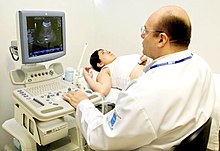
Back Ultraklank Afrikaans موجة فوق صوتية Arabic Ultrasoníu AST Ultrasəs Azerbaijani Ультрагук Byelorussian Ультрагук BE-X-OLD Ултразвук Bulgarian শ্রবণাতীত শব্দ Bengali/Bangla Ultrazvuk BS Ultrasò Catalan

Ultrasound is sound with frequencies greater than 20 kilohertz.[1] This frequency is the approximate upper audible limit of human hearing in healthy young adults. The physical principles of acoustic waves apply to any frequency range, including ultrasound. Ultrasonic devices operate with frequencies from 20 kHz up to several gigahertz.
Ultrasound is used in many different fields. Ultrasonic devices are used to detect objects and measure distances. Ultrasound imaging or sonography is often used in medicine. In the nondestructive testing of products and structures, ultrasound is used to detect invisible flaws. Industrially, ultrasound is used for cleaning, mixing, and accelerating chemical processes. Animals such as bats and porpoises use ultrasound for locating prey and obstacles.[2]
- ^ Dance D, Christofides S, Maidment A, McLean I, Ng K, eds. (2014). "12: Physics of Ultrasound". Diagnostic Radiology Physics: A Handbook for Teachers and Students. Vienna, Austria: International Atomic Energy Agency. p. 291. ISBN 978-92-0-131010-1.
- ^ Novelline R (1997). Squire's Fundamentals of Radiology (5th ed.). Harvard University Press. pp. 34–35. ISBN 978-0-674-83339-5.
© MMXXIII Rich X Search. We shall prevail. All rights reserved. Rich X Search